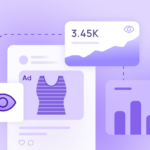
Understanding the impact of various marketing channels on customer behavior and sales is crucial for businesses. Cross-channel attribution is a method that helps marketers determine how different marketing channels contribute to conversions and sales.
This detailed guide will walk you through the essentials of cross-channel attribution, its importance, methodologies, and best practices.
Jump ahead to:
What is Cross-Channel Attribution?
Customers rarely interact with a brand through a single channel. They might see a social media ad, then visit the company website after reading a blog post, and finally make a purchase in-store after receiving a discount code via email. This complex customer journey highlights the importance of cross-channel attribution.
Cross-channel attribution helps marketers understand the contribution of each channel in a customer’s journey, from initial awareness to final purchase. By analyzing the interactions across various touchpoints, businesses can optimize their marketing strategies, improve customer engagement, and allocate budgets more effectively.
Additional Read: Last-Click Vs. Data-driven Attribution Models
What is Cross-Channel Data-Driven Attribution in GA4?

In GA4, cross-channel data-driven attribution uses machine learning to assign credit to different marketing channels based on their contribution to conversions. Unlike traditional attribution models, data-driven attribution considers the unique customer journey and adjusts the credit assigned to each touchpoint based on its impact.
How Cross-Channel Data-Driven Attribution Works in GA4
GA4 uses machine learning to determine the value of different touchpoints in the conversion path. Here’s how it works:
- Data Collection: GA4 collects data from various touchpoints across channels, including website interactions, app usage, and offline conversions. This data forms the basis for analysis.
- Model Training: GA4 employs machine learning algorithms to analyze historical data and learn how different touchpoints influence conversions. This involves understanding the patterns and sequences of user interactions.
- Attribution Calculation: GA4 assigns credit to each touchpoint in the user’s journey based on the model’s insights. The credit is proportional to each touchpoint’s impact on the conversion, rather than following a fixed rule.
- Reporting and Insights: GA4 provides detailed reports and insights on how various touchpoints contribute to conversions. This helps in evaluating the effectiveness of different channels and strategies.
How to Set Up Cross-Channel Data-Driven Attribution in GA4
To set up and utilize cross-channel data-driven attribution in GA4, follow these steps:
- Configure Your GA4 Property: Ensure that your GA4 property is properly set up to track all relevant touchpoints across your marketing channels. This includes configuring data streams for your website, mobile app, and any other sources of user interactions.
- Enable Data-Driven Attribution: GA4 automatically uses data-driven attribution for properties that have sufficient data. Ensure that your property meets the data requirements for GA4’s machine-learning algorithms to function effectively. This typically requires a substantial amount of historical data.
- Review and Interpret Attribution Reports: Access attribution reports in GA4 to review how different channels and touchpoints contribute to conversions. These reports include:
- Conversion Paths: Visualize the sequence of touchpoints leading to conversions.
- Channel Contributions: Understand the relative impact of different channels on conversion outcomes.
- Custom Attribution Models: Explore and compare data-driven attribution with other attribution models available in GA4.
- Optimize Based on Insights: Use the insights gained from GA4’s data-driven attribution to make informed decisions about your marketing strategies. Adjust your budget allocation, optimize campaigns, and refine your overall marketing approach based on the performance data.
Channel-Level vs Campaign-Level Attribution

Two common levels of attribution are channel level and campaign level. Analyzing attribution at both channel and campaign levels allows for a comprehensive view of marketing performance.
What is Channel-Level Marketing Attribution ?
At the channel level, attribution models provide a high-level view of performance. They allow marketers to see which channels are driving the most conversions and optimize their budget allocation accordingly. For instance, if a company notices that the “Paid Search” channel is performing well, it might increase its investment in that channel to capitalize on its effectiveness.
Channels are broad categories through which advertising is delivered. Examples include:
- Affiliation: Content purchased through affiliate programs.
- Paid Search: Ads displayed in search engine results.
- Display Programmatic: Ads purchased through demand-side platforms (DSPs).
- Display Premium: Direct deals with publishers for display ads.
- Paid Social: Promoted content on social media platforms.
- Direct: Traffic from users directly typing the URL.
- Email: Marketing content delivered via email.
- Organic: Non-promoted search engine traffic.
- Metasearch: Traffic from metasearch engines.
What is Campaign-Level Marketing Attribution?
Campaign-level attribution, on the other hand, operates at a more detailed level. Campaigns are specific marketing efforts within a channel and can be configured differently depending on the channel type. For example:
- Search Campaigns: Divided into ad groups.
- Display Campaigns: Organized by placements.
- Social Campaigns: Managed through ad sets.
Campaign-level attribution provides detailed insights into various parameters such as:
- Advertiser
- Strategy (e.g., Prospecting, Retargeting, Shopping)
- Program (e.g., Marketing Campaign Type)
- Language
- Target Country
Despite the detailed insights offered, campaign-level attribution models are less commonly used. This is surprising given that budgets are usually allocated at the campaign level. The detailed view at this level provides a deeper understanding of the effectiveness of specific campaigns, which can be critical for optimizing marketing strategies.
Additional Read: Using Data-Driven Attribution Model in Marketing
Challenges of Marketing Attribution Models
One of the main challenges in attribution models is the incomplete tracking of user paths. Advertisers use various platforms to record touchpoints, but these platforms often do not share data. For instance:
- Google Campaign Manager: Records clicks but may not track impressions on other platforms like Facebook.
- Platform Data Silos: Different platforms (e.g., Google, Facebook, Twitter) often have separate systems that do not integrate seamlessly.
This lack of integration can lead to incomplete data and potentially skewed attribution results. Understanding this limitation is crucial for interpreting attribution data accurately and making informed decisions.
Additional Reading: What are Data Silos and Why are they Bad?
Addressing Challenges to Marketing Attribution Models:
- Integration Tools: Utilize tools that integrate data from various platforms to get a comprehensive view of user interactions.
- Cross-Platform Tracking: Implement tracking mechanisms that capture user interactions across different platforms to reduce data silos.
- Regular Data Audits: Conduct regular audits of data integration processes to ensure accurate and complete tracking.
Additional Read- Role of First-Party Data in Multi-Channel Content Distribution
EasyInsights for Accurate Cross-Channel Attribution
Cross-channel attribution in Google Analytics 4 offers a sophisticated approach to understanding how various marketing channels contribute to conversions. By leveraging data-driven attribution, GA4 provides a nuanced view of customer journeys, allowing businesses to accurately assess the impact of each touchpoint.
This method contrasts with traditional attribution models by using machine learning to assign credit based on actual influence rather than fixed rules, enabling more precise optimization of marketing strategies. However, attribution models face challenges, such as incomplete tracking and data silos, which can skew results and hinder accurate analysis. Addressing these challenges through integration tools, cross-platform tracking, and regular data audits can help ensure more accurate and actionable insights.
For businesses looking to streamline their marketing analytics and overcome these challenges, EasyInsights offers an advanced analytics solution designed to enhance cross-channel attribution. EasyInsights integrates data from various platforms, providing a unified view of your marketing performance and actionable insights to optimize your strategies. By adopting a comprehensive approach to attribution and utilizing tools like EasyInsights, businesses can achieve a more accurate understanding of their marketing effectiveness, leading to improved decision-making and more successful marketing campaigns.








